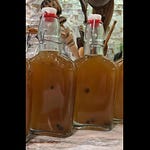TRANSCRIPT Ep 18 Cheap Thrills
Welcome to The Simmering Chef.
Cooking with a smidgen of anger, a pinch of crass, a dollop of irreverence, a sprinkling of science, and a handful of spice.
Hello and welcome to all my listeners! It’s a new day here at the Atelier Rorschach Culinary Studios in beautiful College Park, home of me, The Simmering Chef. In the transcript is a photo of my CEO and executive producer, Sadie Mae Rorschach, overseeing the quality of this episode with her usual relaxed style and non-aggressive feedback. So far, her only criticism has to do with her treat distribution frequency. I’m on it, Sadie. I’m on it. Say hello, Sadie. Say hello.
Today’s letter is from the Eastcoast of the States. Hello, Maryland! Let’s jump in.
Dear The Simmering Chef,
I love mussels, especially the Green Lip ones from New Zealand, and I always get a delicious bowl of mussels with all that lusciously buttery broth when I go to my favorite local seafood restaurant. When I was in the grocery store the other day, I noticed they were really cheap, five pounds for five dollars. Something I love is inexpensive? BONUS! My problem is, I don’t know how to clean and cook them. Would you please give me some guidance so I may enjoy them at home?
Mussel Mad in Milford Mill, Maryland
Dear Alliteration-Mad Maryland,
Oh, you are a lucky person to enjoy the mollusk that is mussels. My friend, Richard, is deathly allergic to them. Richard, if you are listening and didn’t stop listening at the mention of mussels, stop now, please.
Mussels are a superb economical source of protein, with about 20 grams found in every 3 ounces of meat. What’s really lovely about mussels is they can get from your refrigerator to the table in about 15 minutes. That’s what I call a quick meal!
I will break buying and cleaning mussels down for you in three parts, so listen up.
BUYING
Although you can buy mussels year-round, the peak mussel-buying season is October through March. We’ve got another good month to enjoy them.
Mussels must be bought living or frozen. The living mussels should be kept on ice. Once they’ve croaked, you’re playing Russian roulette with your intestines. Mussels can live a few days out of water, but that’s it.
You know you are buying from a good shop when it smells clean or like the ocean, and they keep the mussels over and under ice in a breathable environment. They are not smothered. Also, the shells should be glistening and moist-looking. If the shells look dry, the mussels inside are likely dying or, worse, have died from thirst, which is an awful fate for a mussel.
Some markets have wild mussels, but typically, what you’ll find are farm-raised. These are perfectly fine to consume. Farm-raised mussels are very safe and are genuinely beneficial to the environment. According to Seafood Choice Alliance, they improve coastal water health by filtering between ten to fifteen gallons of seawater per day.
Farm-raised mussels are cleaner because they are grown on a length of rope, unlike wild mussels, which grow on seabeds and rock walls. Also, farm-raised are held in tanks, which helps the purging process*, a helpful step you don’t have to do.
*Purging filters all the muck and sand from the mussels' systems so they aren’t gritty when you eat them. I remember feeding the restaurant’s tanked mussels a bunch of cornmeal to help them purge all that crap out. Oh, those were the days when I was the mussel and lobster girl.
Link to Seafood Watch, which gives you information on the safety and health of seafood around the world. The link takes you directly to their mussel recommendation.
HOW MUCH SHOULD YOU BUY PER PERSON?
Plan on at least half a pound of shell-on mussels per person.
NOTE: Mussels come in two varieties: black and green. Typically, black mussels have a low meat-to-shell ratio; sometimes, as low as 20% of their weight will be meat and the rest shell!
Green mussels are rarer to find but have a much higher meat-to-shell ratio, usually 50%. Probably that’s why you like the New Zealand Green Lip mussels so much. They are very meaty.
CLEANING
When you get home from the store, the first thing you want to do is clean the mussels.
Farm-raised mussels are reasonably clean and don’t require the heavy water-scrubbing and beard-yanking like I used to do in the old days. Some of those beards were sons-of-bitches to remove. Ah, the yanking. I remember grabbing pliers once.
You will still need to give them a quick look-over, but that’s easy compared to the old days.
Add your mussels to a colander, rinse them with cold water, and scrub as necessary. This should help get rid of any seaweed and debris clinging to their outer shells. If any shells feel muddy, use your fingers to rub the mud off.
The mussels’ beards are how they attach and stabilize upon surfaces. That makes them really strong. Typically, most farm-raised mussels come debearded, but there are always some stubborn bastards that need a good yank. (What bastard doesn’t?) Grasp the strand between your thumb and forefinger and firmly pull it toward the tapered end of the shell—this is where the hinge is, the area that connects the two shells. Once removed, discard the strand. If it’s slippery, use a paper towel to clasp it.
Check for the dead and the dying mussels by looking for the gape. If the shells are gaping open and don’t close up when you squeeze or clack those shell lips together a couple of times, DISCARD! Shell cracked? DISCARD! Life is far better lived without risking the excruciating pain delivered when you’ve eaten a long-dead, bad mollusk.
That’s it. You are ready to cook your mussels. In the transcript, you’ll find a SAVEUR recipe for spaghetti with mussels I adapted. Feel free to use mine or SAVEUR’s as a guide; you won’t go wrong with either of them.
As always, fail brilliantly and eat well. Thank you for listening.
This is Janet, The Simmering Chef
Today’s podcast is brought to you from the Atelier Rorschach Culinary Studios in beautiful College Park. Music is “Cheap Thrills” by Sia, featuring Sean Paul. Content is all my fault. Feel free to complain to the management.
PONZA-STYLE SPAGHETTI WITH MUSSELS
Adapted from SAVEUR.
When this popped up on my Instagram feed, there was no thought other than that I had to make it immediately. I fondly remember the original “SAVEUR” magazine, and I am thrilled that it’s returning to print in March. I can’t wait to hold the hot print edition in my cold hands.
INGREDIENTS
2 pounds fresh mussels, cleaned and ready to go
Sea salt
1 pound dry gluten-free or regular spaghetti (I use Bonza)
¼ cup extra-virgin olive oil
3 garlic cloves, d, smashed with the side of a knife and roughly chopped
12 cherry tomatoes, halved
1 cup dry white wine
¼ to ½ teaspoon red chili flakes
1+ Tablespoons minced fresh parsley
METHOD
Follow the manufacturer’s instructions to cook the pasta, but only cook it to al dente, about 5 - 7 minutes.
Before draining the pasta, reserve 1 cup of hot liquid (to use, if needed, to make the sauce.)
Drain the pasta.
Place a large Dutch oven over medium-low heat.
Add the olive oil and garlic.
Stirring occasionally, cook the garlic until it begins to brown.
Add the tomatoes and season with salt.
Turn the heat up to medium.
Stirring occasionally, cook the tomatoes until they start to break down and release their juices.
Turn the heat up to medium-high.
Add the mussels, white wine, and chili flakes.
Skahing the pan occasionally, cook the mussels until they open.
Using tongs or a spider strainer, remove the opened mussels from the pot and transfer them to a bowl.
Discard any mussels that do not open.
Set the mussels aside to cool enough to handle.
Pull the meat from all but a dozen mussels.
Return the Dutch oven to medium-high heat.
Bring the liquid to a boil and reduce for about 3 minutes or until it looks smooth and silky.
Add the pasta and cook, swirling it in the t until it is al dente and coated with the sauce.
Add some of the reserved pasta liquid if the pasta seems dry or you want the dish to be more saucy.
Stir in the shelled and unshelled mussels and allow them to heat through for about one minute.
Remove the pot from the heat and plate into warm pasta bowls.
Make sure each bowl gets some of the shell-on mussels.
Garnish with the minced parsley.
Eat immediately.















Share this post